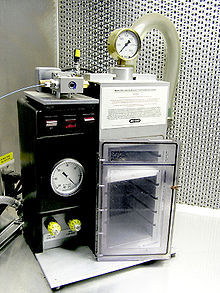Gene gun
A gene gun (English gene gun ) is a device that serves to DNA with the aid of particles in cells (engl. Shoot particle bombardment or transfection biolistic of bio-ballistic ). In addition to protoplast transformation and agrobacteria-mediated transformation , particle bombardment with a gene gun is an established method for generating transgenic organisms or for transient transfection to generate an immune response .
Development history
The concept of the gene cannon was invented by Edward Wolf and Nelson Allen of the Cornell Nanofabrication Facility, and plant physiologists John Sanford and Theodore Klein of Cornell University in 1987. The rights to commercialize the products were sold to DuPont in 1990 .
In addition to the developers' comment that the method should be used universally for the introduction of substances into living cells, the main focus was originally on the development of a method to transform plants that were not accessible with other transformation methods . For example, at the time the method was developed, it was not possible to transform monocots with Agrobacterium tumefaciens . Almost all plants can be transformed using the particle bombardment method , and plasmids can also be introduced into plastids . Although plants do not have plasmids themselves, they can integrate the plasmid DNA on the particles into their own genome . A transfection is either transient, i.e. only temporary, or stable with inheritance in the next generations through integration of the DNA into the genome. In the meantime, however , protocols for transformation with agrobacteria have been published for all monocotyledonous grains, including maize and barley .
The gene cannon was first used on animals in 1990 and was also used for immunization purposes from 1993 onwards. A mobile variant in the form of a high-pressure gun connected to a nitrogen pressure bottle is used for this. Power is supplied by a 9 volt battery.
Particle texture
In most cases, the particles consist of gold or tungsten and are coated with plasmid DNA. Shooting is done with gas pressure. The developers of the method initially used tungsten particles with a diameter of 4 µm. Recently, mostly smaller particles have been used, for example gold particles with a size of 1.0 µm or 0.6 µm. It could be proven that smaller particles significantly increase the effectiveness of creating transgenic plants with the bombardment. The particles are coated with a polyamine (e.g. spermidine ) to improve the adsorption of the DNA onto the particles. After the DNA coating, there is usually a final coating with a cationic polymer (e.g. polyvinylpyrrolidone ) in order to improve the transfection efficiency.
Target tissue
Epidermal tissue or callus material, for example, can be used as the target tissue ( target ) for the generation of transgenic plants . The particles penetrate thousands of cells simultaneously and make it possible to introduce DNA into cells in situ .
Advantages and disadvantages
Particle bombardment has the advantage of being more effective in most cases, but the number of stable integrations of foreign DNA into the genome is lower in most cases compared to agrobacterial transformation. The high procurement and operating costs for a gene gun must also be considered. The protoplast transformation and the agrobacteria-mediated transformation are significantly cheaper here.
For vaccination purposes, cellular expression and the presentation of the peptides to the main histocompatibility complex MHC-I show a cellular immune response . Further characteristics are a high reproducibility at a hundred times lower dosage compared to intramuscular injection of plasmids and an expression in situ with correct protein folding and all post-translational modifications . The process is needle-free and does not require a cold chain .
See also
Web links
- Have you ever set the cannon? Plant cells are genetically modified at the MPI with the help of the particle cannon (with video).
Individual evidence
- ↑ Sanford, JC, TM Klein, et al. (1987). Delivery of substances into cells and tissues using a particle bombardment process. Journal of Particulate Science and Technology 5: 27-37.
- ↑ a b c d e f Klein, TM, ED Wolf, et al. (1987). High-velocity microprojectiles for delivering nucleic acids into living cells. Nature 327 (6117): 70-73.
- ↑ Ishida, Y., Y. Hiei, et al. (2007). Agrobacterium-mediated transformation of maize. Nature Protocols 2 (7): 1614-1621.
- ↑ Ishida, Y., H. Saito, et al. (1996). High efficiency transformation of maize (Zea mays L.) mediated by Agrobacterium tumefaciens. Nature Biotechnology 14 (6): 745-750.
- ↑ Tingay, S., D. McElroy, et al. (1997). Agrobacterium tumefaciens-mediated barley transformation. Plant Journal 11 (6): 1369-1376.
- ↑ N. Yang, J. Burkholder, B. Roberts, B. Martinell, D. McCabe: In vivo and in vitro gene transfer to mammalian cells by particle bombardment. In: PNAS 87: 9568 (1990)
- ↑ JB Ulmer, JJ Donnelly, SE Parker, GH Rhodes, PL Felgner, VJ Dwarki, SH Gromkowski, RR Deck, CM DeWitt, A. Friedman: Heterologous protection against influenza by injection of DNA encoding a viral protein. In: Science 259 (5102): 1745-9 (1993)
- ↑ a b c B. R. Frame, HY Zhang, et al. (2000). Production of transgenic maize from bombarded type II callus: Effect of gold particle size and callus morphology on transformation efficiency. In Vitro Cellular & Developmental Biology-Plant 36 (1): 21-29.
- ^ S. Wang, S. Joshi, S. Lu: Delivery of DNA to skin by particle bombardment. In: Methods in molecular biology. Volume 245, 2004, pp. 185-196, PMID 14707379 .
- ↑ TM Pertmer, MD Eisenbraun, D. McCabe, SK Prayaga, DH Fuller, JR Haynes: Gene gun-based nucleic acid immunization: elicitation of humoral and cytotoxic T lymphocyte responses following epidermal delivery of nanogram quantities of DNA. In: Vaccine 13 (15): 1427-30 (1995).
